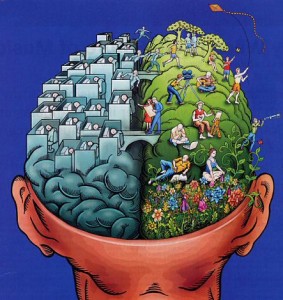 I thought it might be useful to list some common traits brought up by parents wondering if their child is a right-brained dominant learner. The most important reason that I share the right-brained information is to help adults shift perspective about what is normal in learning. Because school tends to be the common denominator among us, we tend to use that as the measuring stick in defining normal. Unfortunately, viewing children and learning through the school lens has been the biggest downfall to understanding and honoring the right-brained dominant learner because school primarily supports left-brained learning traits and time frames. That said, most of us will first come to the right-brained information from a reaction over how our child learns differently than school promotes. So…
I thought it might be useful to list some common traits brought up by parents wondering if their child is a right-brained dominant learner. The most important reason that I share the right-brained information is to help adults shift perspective about what is normal in learning. Because school tends to be the common denominator among us, we tend to use that as the measuring stick in defining normal. Unfortunately, viewing children and learning through the school lens has been the biggest downfall to understanding and honoring the right-brained dominant learner because school primarily supports left-brained learning traits and time frames. That said, most of us will first come to the right-brained information from a reaction over how our child learns differently than school promotes. So…
Your child might be right-brained if you worry about…
… why your child resists being taught.
There are probably many reasons for this. The top reason is that you are probably not teaching in the way the child learns. We tend to teach like we were taught, as found in school, which supports left-brained learning practices. Right-brained children have a very different path and process to learning. In actuality, right-brained children love to learn, but hate to be taught. The process of learning taps into their creative energy; the products of learning often fall flat.
What can I do? Redefine learning from the products we strive toward as proof of learning and embrace the process of learning that ignite passion. Make space for and honor a different subject focus that includes right-brained early subject strengths and the creative outlets.
…why your child isn’t reading yet.
By 7 years old, that is. We’ve bought into the idea that learning to read is as easy as Baby Einstein hook, line, and sinker. And it is meant to be a painless process. But, we only allow that to occur if it falls in the time frame espoused by schools as the time all children are supposed to be ready to read: between 5 and 7 years old. The normal time frame for right-brained children to learn to read is between 8 and 10 years old. The answer to why this is lies in the foundational right-brained learner’s traits of an amazing visual, pictorial mind and their three-dimensional gifts. The foundational traits for left-brained learners is words and sequence. This supports early reading (between 5 and 7) while the foundational traits of right-brained learners of pictures and three-dimensionality supports early knowledge in subjects like history, science, and geography followed by reading later (between 8 and 10).
What can I do? Shift your perspective and embrace the idea that there is more than one time frame for legitimate reading acquisition. Encourage and support the development of the foundational traits of right-brained children during the 5 to 7 year development stage. By strengthening their pictorial imagery, three-dimensional abilities, and imagination, it actually aids in their painless transition in learning to read. This can include reading aloud, promoting a positive relationship with print, and giving value to visual resources.
…why your child spends a lot of time playing video games, drawing, or building with LEGO. When will he do real work?
This is real work to a right-brained child. In fact, they will often go into a field associated with or motivated by a creative outlet. The creative outlets are art/photography, building/electronics, theater/showmanship, math/numbers, puzzles/mazes, cooking/gardening, fashion/sewing, video games/computers, and music/dance. These use the best of the gifts of the right-brained person: creativity/imagination and pictorial/three-dimensionality. These are core subjects for right-brained children, not extra-curricular like our culture treats them.
What can I do? Treat the creative outlets with the value it deserves in the lives of these creative beings. You will soon notice that they filter their learning through their preferred creative outlet. I saw my builder son create a pyramid from LEGO with intricate detail of mazes within. I saw my artist son draw his own geography maps with area animals. I saw my nature daughter gain all her science knowledge simply by being outdoors observing it in action. I witnessed my “disabled” son with autism become interested in architecture from his love of electronics/ceiling fans and now volunteers at the Habitat ReStore repairing electronics. When valued, the benefits of the creative outlets become obvious.
…why your child can’t memorize her math facts? We can’t move on until it’s mastered.
Where did this idea come from? Basically, school. Since school focuses on arithmetic, and one idea building on another, then the idea that one can’t progress without certain abilities seems to make sense. At least for a sequential, part-to-whole learner it does, which is how many left-brained learners process information, and, thus, how schools progress. But, it’s not how right-brained learners process information. They are whole-to-part learners. They learn concepts first, then facts. This also supports the idea that they are better at long-term memory than short-term memory. Memorization uses short-term memory. An understanding of concepts uses long-term memory and the route of learning by association (applying knowledge).
What can I do? How freeing it can be to understand that one math mind isn’t better or worse than another. Both math minds can have value. Once that shift occurs, we can support the math process of our right-brained children. As comfortable as it can be for those of us who logically “get” the sequential order of math found in school, we have to give space to learn math globally, seemingly learning this over here and that over there. We have to trust that they have the big picture to place these pieces in the grand scheme of math that then motivates them to learn the arithmetic in context. And there are actually resources out there that support this! The living math website, a story context resource, and a concept context resource, to name a few. Here’s even a study to support it!
…why your child is beginning to say he’s stupid.
Most right-brained children are highly sensitive. They know when they’re not measuring up. It’s painful. The bottom line is that we choose if we bring our culture into our homes or not. The left-brained measuring stick is ingrained in us through thirteen plus years of schooling. There’s another valid way of learning; it simply looks differently than that found in school.
What can I do? Understanding that there is another valid path to learning is crucial. Learning still happens for both, just in its own season. More times than not, parents are fearful about taking the education journey with their child. They don’t want to mess them up. They don’t want to make a mistake. Life is all about imperfection. It’s not possible to go through it flawlessly. Your child will need that model from you about going through life with faith. It’s important.
As a left-brained parent learning alongside primarily right-brained children, I had to adjust several things in order to give them the learning environment they flourish in. First, learning had to come from inspiration and creativity, not from a checklist. Sure, I get all excited over checklists and completing a paper; not so for my imaginative children. Second, I could be a model for passion-inspired learning. Even though I’m left-brained, I certainly get excited when someone else is excited about what they’re doing. And, third, what did I have to shift the most? What was my primary role? Being available. Be, not do. Not easy for a Type A personality.
I’m grateful for the journey my right-brained children took me on in opening my mind and understanding to another way of viewing life and learning. I am better for it! I even got to tap into my own under-used creative side as well as the beauties of my quieter side. Even though I still enjoy creating products, I enjoy the process so much more now. And my achievements don’t define me. It truly freed me from the culture that can bind us. I am significant as I was created to be, as are each of my children. It’s a beautiful thing…
So, after the shift of understanding happens, the proactive statement becomes:
Your child might be right-brained if…
…he has an extraordinary imagination.
 A quote from my book, The Right Side of Normal: “Naturally, childhood is a time of playing pretend and using one’s imagination, but with the right-brained child, you’ll notice he goes beyond the typical left-brained reality-based elements of expression.” I go into detail in Chapter Five about the different ways imaginative play is expressed in right-brained children.
A quote from my book, The Right Side of Normal: “Naturally, childhood is a time of playing pretend and using one’s imagination, but with the right-brained child, you’ll notice he goes beyond the typical left-brained reality-based elements of expression.” I go into detail in Chapter Five about the different ways imaginative play is expressed in right-brained children.
…she thinks in pictures.
Temple Grandin, in her book, Thinking in Pictures, shares this about her visual imagery: “I create new images all the time by taking many little parts of images I have in the video library in my imagination and piecing them together. I have video memories of every item I’ve ever worked with―steel gates, fences, latches, concrete walls, and so forth. To create new designs, I retrieve bits and pieces from my memory and combine them into a new whole. My design ability keeps improving as I add more visual images to my library.” Thinking in pictures is a rich, holistic way of processing information. According to Einstein, he considers it an advanced process and the key to his genius.
….he processes images three-dimensionally.
A quote from my book, The Right Side of Normal: “Three-dimensional viewing, one of the universal gifts of the right-brained learner, is the ability to see an object from every angle as a whole object. A LEGO® block in your hand is three-dimensional; you can see it from every angle, or turn it to see every angle. Your pet dog is three-dimensional. Each of these is concrete. You can touch it; manipulate it; visualize all its components.” This is why they like to learn in the early years with hands-on activities. This is why they like images, maps, and subjects like history, geography, and science in the early years of 5 to 7 years. Between 8 and 10 years old, right-brained children begin to integrate two-dimensional processing, which includes reading and math facts. It’s just a different process order than school promotes.
…she spends hours dancing, building LEGO, and drawing.
A quote from my book, The Right Side of Normal: “For the right-brained learner, deep engagement in one or more of these areas of creative outlet is at the core of development. If these people aren’t creatively engaged, they only half live. And yet, our society currently views these pursuits as extracurricular at best, a waste of time at worst. School budget cuts begin with creative outlets even though they should be the center of early years’ study for these learners.”
And later, “Creative outlets inherently develop the strengths of the right-brained learner so he may joyfully continue academic pursuits in the subsequent learning years.”
Let’s add to the list…your child might be right-brained if…
If you benefited from this content, please consider supporting me by buying access to all of my premium content for a one-time fee of $15 found here. This will even include a 50% off e-mail link toward a copy of my popular The Right Side of Normal e-book (regularly $11.95)!


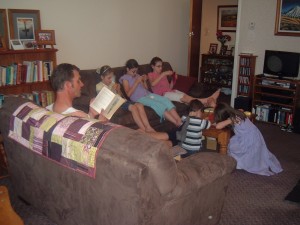
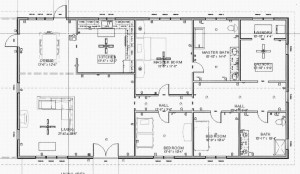
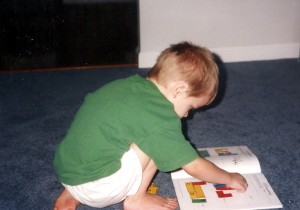
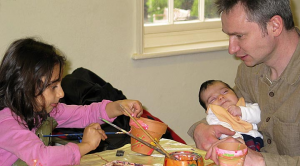
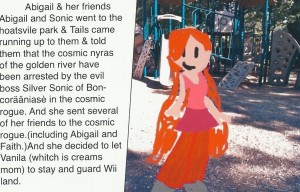





Pingback: A Boca Raton Tutor, Kumon (R) and 3D Learner Controversy
Pingback: The Universal Gifts | The Right Side of Normal
Pingback: A Boca Raton Tutor, Kumon (R) and 3D Learner Controversy
Pingback: There are no Educational Emergencies | The Right Side of Normal